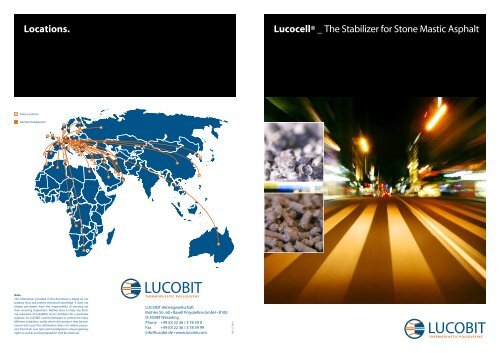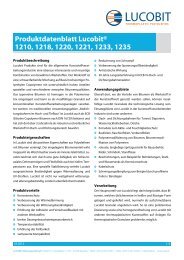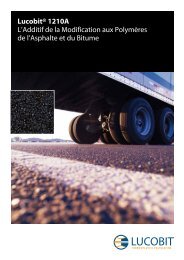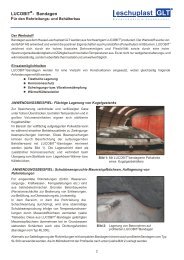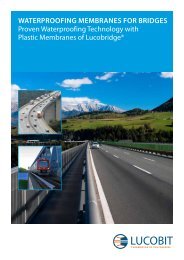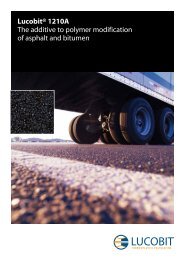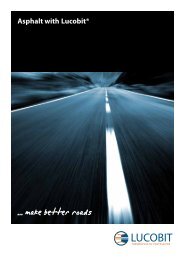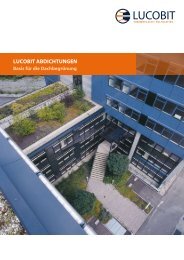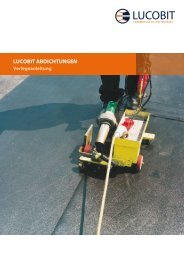Lucocell® _ The Stabilizer for Stone Mastic Asphalt Locations.
Lucocell® _ The Stabilizer for Stone Mastic Asphalt Locations.
Lucocell® _ The Stabilizer for Stone Mastic Asphalt Locations.
Create successful ePaper yourself
Turn your PDF publications into a flip-book with our unique Google optimized e-Paper software.
<strong>Locations</strong>.<br />
Sales <strong>Locations</strong><br />
German Headquarter<br />
Note<br />
<strong>The</strong> in<strong>for</strong>mation provided in this document is based on our<br />
product tests and present technical knowledge. It does not<br />
release purchasers from the responsibility of carrying out<br />
their receiving inspections. Neither does it imply any binding<br />
assurance of suitability of our products <strong>for</strong> a particular<br />
purpose. As LUCOBIT cannot anticipate or control the many<br />
different conditions under which this product may be processed<br />
and used this in<strong>for</strong>mation does not relieve processors<br />
from their own tests and investigations. Any proprietary<br />
LUCOBIT Aktiengesellschaft<br />
Brühler Str. 60 • Basell Polyolefine GmbH • B100<br />
D-50389 Wesseling<br />
Phone +49 (0) 22 36 / 3 78 59 0<br />
Fax +49 (0) 22 36 / 3 78 59 99<br />
info@lucobit.de • www.lucobit.com<br />
rights as well as existing legislation shall be observed. LAG_LC_0312<br />
LAG_LC_0111<br />
<strong>Lucocell®</strong> _ <strong>The</strong> <strong>Stabilizer</strong> <strong>for</strong> <strong>Stone</strong> <strong>Mastic</strong> <strong>Asphalt</strong>
_ More durability of asphalt.<br />
<strong>The</strong> efficiency and utility value of our roads is dependent on<br />
various climatic <strong>for</strong>ces and traffic related developments. <strong>The</strong><br />
number of motorists increases exponentially and particularly<br />
the rise in HGV traffic with higher axle loads is straining roads<br />
in a way that one can detect poor resistant of road by ruts<br />
and cracks just by looking it. Taking into account the structurally<br />
accurate execution, we have to confront the increase<br />
in traffic growth with new solutions.<br />
Those top layers that are especially strained have to be<br />
technically enhanced with regards to their durability. With<br />
budgets being tight and natural reserves becoming more<br />
rare and there<strong>for</strong>e more expensive, future approaches will<br />
result in recycling and working with increasingly reduced<br />
layers of asphalt.<br />
Technical Data<br />
Current situation in<br />
Using <strong>Stone</strong> <strong>Mastic</strong><br />
<strong>Asphalt</strong> (SMA).<br />
Character Value FG3000 Value PE3700 Unit<br />
Appearence Micro grain Grey granule -<br />
Bulk density Approx. 450 Approx. 370 g/l<br />
Basic fibre Value FG3000 Value PE3700 Unit<br />
Average fibre length Approx. 1100 Approx. 1100 µm<br />
Average fibre diameter Approx. 45 Approx. 45 µm<br />
Typical screen analysis Value FG3000 Value PE3700 Unit<br />
Less than 2500µ 100 100 %<br />
Less than 800µ Min. 55 Min. 55 %<br />
Less than 200µ Min. 30 Min. 30 %<br />
Polymer Value FG3000 Value PE3700 Unit<br />
Ethylene Copolymer (EBA) not available 37 %<br />
<strong>The</strong>se standard values are typical values and should not be regarded as specifications.<br />
_ Advantages of <strong>Lucocell®</strong> in SMA<br />
_ higher resistance against mechanical strain<br />
_ higher resistance against de<strong>for</strong>mation and wear & tear<br />
_ stronger affinity with grit<br />
_ higher level of stability<br />
_ low temperature of flexibility<br />
_ ageing resistance<br />
_ reduced thickness of courses<br />
_ higher bleading resistance<br />
_ <strong>Lucocell®</strong> fits in all road types<br />
where SMA is used<br />
_ motorways with highfrequency traffic,<br />
_ fast roads,<br />
_ roads with high traffic loads<br />
<strong>Lucocell®</strong> FG3000<br />
micro grains of<br />
cellulose fibres and<br />
<strong>Lucocell®</strong> PE3700<br />
granules powered<br />
with special polymers.<br />
_ New standard in stabilizing SMA.<br />
<strong>Lucocell®</strong> – cellulose additives <strong>for</strong> SMA – <strong>Stone</strong> <strong>Mastic</strong> <strong>Asphalt</strong>.<br />
Due to their 3D structure, cellulose fibres maintain a comparatively<br />
high viscosity of bitumen, thus preventing its seepage<br />
and <strong>for</strong>mation of asphalt mix segregation at high temperatures<br />
during storage, transport and SMA placing. At the<br />
same time they enable creation of a thicker bitumen layer<br />
around each rock particle, thus preventing oxidation, moisture<br />
penetration and lifting or cracking of the aggregate.<br />
_ Dosage and mixing.<br />
For dosage of <strong>Lucocell®</strong> shall be introduced centrally into<br />
the mixer. <strong>The</strong> standard dosage rate of cellulose fibre is 0,03<br />
to 0,04 kg of 1 ton mass of asphalt. To achieve this result<br />
batch-sized bags, gravimetric or volumetric fibre blowing<br />
systems can be used. A gravimetric system is preferred <strong>for</strong><br />
receiving the records about the accurate quantity of fibres in<br />
the mix. If a volumetric system is used, it shoud be calibrated<br />
frequently.<br />
<strong>Lucocell®</strong> PE3700<br />
<strong>Lucocell®</strong> FG3000<br />
<strong>Lucocell®</strong> made of cellulose fibre is very safe and easy in<br />
handling. We strongly recommend to pay attention to the<br />
below mentioned aspects of use. <strong>The</strong> advantage of microgranules<br />
is the quicker distribution in the mineral mass during<br />
dry mixing. Microgranules release <strong>Lucocell®</strong> fibres easily<br />
and safely <strong>for</strong> increased efficiency and improved production<br />
quality. <strong>Lucocell®</strong> is ideal <strong>for</strong> use in automated batching.<br />
<strong>Lucocell®</strong> shall be added centrally into the mixer approx.<br />
5-15 seconds prior to the addition of bitumen and even distribution<br />
of the fibres in the mix. In case the fibres are predispersed<br />
by means of a automaticfibre blowing device the<br />
dry mixing of the fibres might not be necessary. <strong>The</strong> total<br />
mixing time <strong>for</strong> SMA according to the German recommendations<br />
(Leitfaden Splittmastixasphalt, Dezember 2000) should<br />
be minimum 53 seconds. This time includes 8 seconds <strong>for</strong><br />
discharging the mixer.


